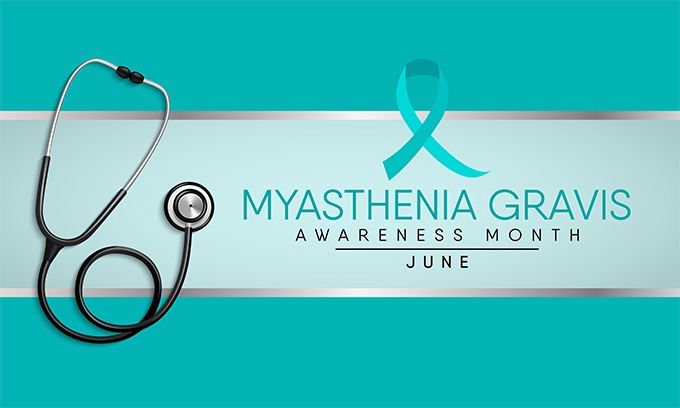

Unveiling Myasthenia Gravis: Top 6 Questions Answered
by Zara Jethani
June is Myasthenia Gravis awareness month. Myasthenia Gravis (MG) is a complex neuromuscular autoimmune disorder that causes weakness and fatigue in the voluntary muscles. This rare, long-term condition results in approximately 36,000 to 60,000 cases in the United States. Learn the answers to the most asked questions surrounding Myasthenia Gravis.

1. What Exactly Is Myasthenia Gravis?
Myasthenia Gravis is an autoimmune disease where the body’s immune system mistakenly attacks its own neuromuscular junctions. These junctions are crucial for communication between nerves and muscles, allowing for voluntary muscle movements. The attack leads to a decrease in the number of receptors for acetylcholine, a neurotransmitter responsible for muscle contractions, resulting in muscle weakness and fatigue.
2. What Are the Symptoms of Myasthenia Gravis?
The hallmark symptom of MG is muscle weakness that worsens with activity and improves with rest, a characteristic known as fatigability. Common symptoms include drooping eyelids (ptosis), double vision (diplopia), difficulty in swallowing (dysphagia), slurred speech (dysarthria), and weakness in the arms and legs. These symptoms can vary widely among individuals and may fluctuate over time.
3. How Is Myasthenia Gravis Diagnosed?
Diagnosing MG often involves a combination of medical history, physical examination, and specialized tests. Physicians may perform a Tensilon test, where a short-acting medication called edrophonium is injected to temporarily improve muscle strength in individuals with MG. Blood tests to detect specific antibodies, such as anti-acetylcholine receptor (AChR) antibodies or anti-muscle-specific kinase (MuSK) antibodies, may also aid in diagnosis. Additionally, electromyography (EMG) and nerve conduction studies can assess the electrical activity of muscles and nerves, helping to confirm the diagnosis.
4. What Are the Available Treatments for Myasthenia Gravis?
While there is no cure for MG, several treatments can effectively manage symptoms and improve quality of life. Medications such as cholinesterase inhibitors (e.g., pyridostigmine) help enhance the communication between nerves and muscles. Immunosuppressive drugs like corticosteroids, azathioprine, or mycophenolate mofetil may be prescribed to suppress the abnormal immune response. In severe cases, intravenous immunoglobulin (IVIg) or plasma exchange (plasmapheresis) can provide temporary relief by removing harmful antibodies from the blood. Additionally, surgical interventions such as thymectomy (removal of the thymus gland) may be considered, especially in individuals with thymoma-associated MG.
5. What Is the Prognosis for Myasthenia Gravis?
The prognosis for MG varies widely depending on factors such as age of onset, severity of symptoms, and response to treatment. With appropriate management, many individuals with MG can lead fulfilling lives with minimal disability. However, some may experience exacerbations of symptoms or require long-term treatment to maintain stability. Close monitoring by healthcare professionals is essential to adjust treatment strategies as needed and optimize outcomes.
6. Are There Risk Factors Associated with Myasthenia Gravis?
Exposure to certain medications poses a significant risk for worsening MG symptoms. Primarily, specific antibiotics and antiviral medications carry this risk. So, it’s crucial for individuals with MG to verify the safety of any prescribed medication for their condition.
>> Download a list of medications that can exacerbate myasthenia

Myasthenia Gravis Treatment at Pacific Neuroscience Institute
Myasthenia Gravis neurology specialist, William Buxton, MD, understands the intricacies of this challenging condition and its significant impact on daily functioning. From identifying symptoms, providing timely diagnosis, and implementing appropriate treatments, Dr. Buxton can help individuals with this condition effectively manage their symptoms and lead fulfilling lives. Ongoing research and advancements in medical care continue to improve our understanding and management of Myasthenia Gravis, offering hope for better outcomes in the future.
About Dr. William Buxton

Dr. William G. Buxton is Director of Neuromuscular & Neurodiagnostic Medicine, and Fall Prevention at the Pacific Brain Health Center. His streamlined methods to optimize safety in outpatient settings, especially related to fall prevention among neurology outpatients have reduced falls and have even trended toward fewer falls among individuals with dementia, a population in which fall prevention efforts had previously been viewed as impractical. Taking a compassionate, whole-person approach, Dr. Buxton also has expertise in diagnosing and treating neuropathies, especially those secondary to autoimmune disorders and other systemic processes.
Myasthenia Gravis Clinic Location
1301 20th St., Santa Monica, CA 904040 | 310-582-7641
Useful Links
About the Author

Zara Jethani
Zara is the marketing director at Pacific Neuroscience Institute. Her background is in molecular genetics research and healthcare marketing. In addition, she is a graphic designer with more than 20 years experience in the healthcare, education and entertainment industries.
Last updated: September 11th, 2024